Feature Interview with Mike Nuzzo
April 2005
Mike Nuzzo, of Nuzzo Course Design, is currently working on projects both across the country and near his office in Houston, Texas. In addition he works as an associate with Baxter Spann of Finger Dye Spann, Inc. and has most recently completed assisting in the renovations of Beaumont Country Club and Las Colinas Country Club in Texas. Mike received his aerospace engineering degree from Boston University.
What is your background?
I have always been a designer, but not always a golf course designer. Prior to moving to Houston, I was a lead mechanical engineer for Lockheed Martin Astro Space, designing satellite antennas – it allowed for a high degree of imagination and innovation.

Mike (third from the right) once led a different kind of construction crew.
There were 2 major portions of a program – design, then integrate and test (I&T). Similar to working on a golf course, there is an extended design phase followed by a large construction effort. The design was great, and the integration was fun, too. I was very efficient at producing a great product and using labor judiciously, which really kept costs low then, as it does today. A good reference point I use to express my technical abilities is that I used to align very large components within a few thousands of an inch. By comparison, it is very easy to get a seed bed mix within an inch and still be very organic looking. Superintendents like hearing about how I manage the details.
Designing a golf course is definitely more creative, and I also have a love of the game. To assistmy transition, I’ve spent as much time as possible working with as many industry leaders as possible. The boredom of hearing the oft repeated comment ‘it’s not rocket science’ brings new levels of tedium for me.
What architects have influenced you?
Baxter Spann has been super personable and a real good and honest person. His technical excellence has been immensely educational. I have also worked on various assignments for about half a dozen other architects, some of which I disagreed with, and it has helped cement my ideas. Spending a lot of time with builders, developers, individual owners and superintendents has been just as gleaning.
I imagine it has been much easier now to amass my collection of out-of-the-ordinary texts and histories than for any other period. Between periodicals, texts and your forum, I have been exposed to a great amount of data.
It is so much fun seeing so many great courses and the different ways greatness was achieved. There was a trip in the past that really established some of my thoughts. I had spent the day walking Oakmont and was obviously thoroughly impressed. A few days later I was playing a very highly regarded modern design, and the differences were striking. Everything fit so ‘cosmetically’ together. No one was trying to blend the bunkering at Oakmont. It’s just there. It was an epiphany, or at least a shifting to what some of my tastes have become. A little more rugged and sporty.
How has and how do you see your career progressing?
Initially I got involved in the business by helping in every way I could, including CAD, surveying, photography and a host of marketing efforts to help create relationships with the people I still work with.
I will be continuing to learn working with Baxter Spann in the near future while I further establish my own individual work, which currently is comprised of assisting existing clubs and various new project developments.
My goal, albeit a very challenging one, is devoting my time to select projects and spending time with my family. I have a great home office which keeps my overhead at a minimum. I also like the quick trip up to the office after seeing my daughter to school and greeting her upon her return when I’m not traveling. As for the workplace, I haven’t seen any others like it. A drawback is I wind up toiling away most evenings.
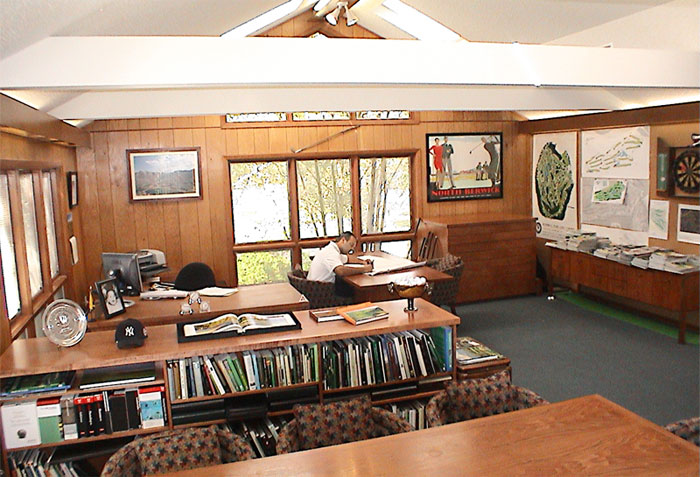
Mike at home in his Houston office.
Describe a hole thatimpressed you during the 2005 GolfClubAtlas.com annual gathering at Casa de Campo.
The First is such a nice introduction and a really good indicator of what to expect. While not my favorite, there are a number of satisfying characteristics. It is quaint as you tee off immediately next to the starter’s shack. There is a line of charm to be avoided. My first time around, after requesting no guidance from our caddy, I went right at the green and wound up in a grassed bunker where I was left with a baseball swing at my waist high ball. My last time around I played it safe over the left fairway bunker with a resultant modest approach. I did make par both ways however? The green complex was very attractive, with a nice left semi-inverted greenside bunker with a tree growing out of the back. It just looked cool. A well contoured green with a significant false front was its best defense. I don’t recall any of my playing partners starting off with a four.
I could really let my guard down to relax and enjoy myself for the truly unique round I was about to enjoy while getting ready to smell the sea and take pleasure in some very memorable moments:
The second shot at three granted me the most choices (3) [Ran even had a fourth option that cost him $40!]; the approach at eight was a blast, especially getting it tight after probably 30 yards of down hill run. The tee shots on the ocean are my favorite and the 5th is delicious, with just the right amount of discomfort to hinder a free swing. I was at level par on the 5th tee twice, but those would be the last times I was even at the Dog.
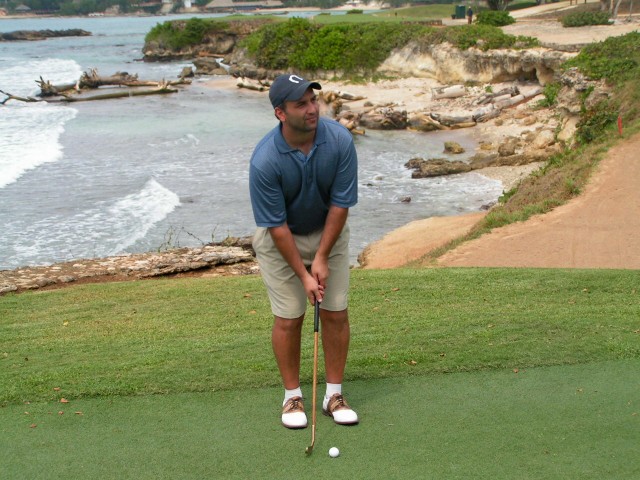
Mike Nuzzo at the 2005 GolfClubAtlas.com gathering at Casa de Campo.
You were most helpful in coordinating the 2003 GolfClubAtlas.comgathering in New Mexico. How would a match comparing the relative merits of Casa de Campo vs. Black Mesa turn out?
In match play they grappled all the way to the 18th with a hard fought handshake to the victor. There were some definite momentum changes throughout the round. The setting in the mountains north of Santa Fe is stunning and almost equal to the quiet reflection the Atlantic permitted at the Teeth of the Dog. The par threes at Casa exceed Black Mesa’s, in part due to the all world settings. The par 4s are close, but I give the edge to Black Mesa, as the lesser holes are more interesting. Black Mesa’s par 5s are what separated the match. The second shots are great at Black Mesa, equal to the first, and, if needed, the third. Both complete sets of greens are varied and fun to play — Black Mesa’s are bolder, which suit the rougher nature of the land. The walk in the park is better at Casa, but I prefer the elevation changes at Black Mesa which helped create great fairways and more assorted approach shots. Ultimately, for me, Black Mesa built up enough of a lead prior to both stretches on the ocean to edge out The Teeth one up. As a side match, I think the food was better in New Mexico, but not the beer.
Texas enjoys wind, a key attribute for good golf. Yet, why are there so many bad courses in Texas, especially Houston?
For starters, Houston is in the flood plain with mostly wet clay soils. It’s flat, and the market is driven by the very good players who like the examination part of the game best. There are also a lot of tree lined courses that block the best natural component, the robust winds. There are a few exceptions, thankfully.
I went to scout a thirty year old course that was recently sold. There was a pond, really a puddle, precisely in front of the first tee with trees in the left landing area and trees right and in front of the green side bunkers. It played like the original geometric penal school that only punishes the poor to average players. There were trees everywhere, not just the opener. For the good player, the course was cake; the average player would be cheerless. It was complete with an island green.
For a development course, it was fairly easy to walk. But surprisingly, I came upon two healthy young players riding a cart. Embarrassed, they said they would never tell their friends that a walker caught up to them. There are very few places that promote walking.
The designer was a former player, and as such, is all knowing and his word is gospel in these parts. I’ve heard some stories about a proclaimed local designer, who often didn’t visit the construction site.
As for Texas’ quality, the irony is that I grew up in NJ with what I thought was no ability to visit all the great courses, and now whenever I go to visit, I stop by one of the greats less than an hour from where I grew up. Now when I could try and visit anywhere, there are very few that are as appealing locally. On the flip side, most of my trips are very memorable.
What is an example of what you would change in Texas?
Wind is a great component, found on the best courses. In general, I’d recommend taking better advantage of our windy conditions. The few courses in Houston that are exposed to the wind have an immediate advantage.
I’d stop the spread out housing courses, which are way too hard to walk and slow to play. I’d like to see more variation with shorter and wider holes with a few hazards thrown in the middle.
As an example, a local course has ample test and not as much variety. There is only room to add a few dozen yards here and there, and that would be at a considerable cost. I proposed swapping two green and tee complexes that would turn four long holes into two longer holes and two short par fours to strengthen the assortment. The shortened holes were also the two blandest on the side. Basically shifting 200 yards from one pair of holes to another. The club liked the idea, but not enough to go ahead and make those significant alterations. A fresh set of talented eyes can make a big difference to the overall quality of a course, often times with just a few detailed enhancements.
What five courses would you go and see if time and money were no issue?
The Old Course
I’m planning to go with my father soon. In the past I would intellectualize my decision to become a designer; it makes a lot of sense. And, I would discount the emotional side of fondly remembering spending time with my father when I was young playing the game he introduced me to. Now I listen to both.
Royal County Down
As a guess, this is the course and place I’d most like to visit, especially in the off season to share a Guinness with the locals after a match.
Bandon
Is there a better business model to emulate in terms of promoting a golf experience?
Sand Hills
To see how Coore and Crenshaw used the most interesting morsels of land, on an enormous site, to create dramatic fairways leading to masterful green complexes.
Painswick
It was one of the first courses I read about after finding Golf Club Atlas, and I knew straight away I was in the right place. I was wholly intrigued by the images of the course. There was no way I’d have ever heard about Painswick otherwise. I’m really disappointed I didn’t play with Goodale here last year. Really disappointed.
What course do you feel is the most overrated?
Bethpage Black.The Black has so many wonderfully laid out holes on choice land, regrettably the excitement ends abruptly at the featureless greens.
How does the modest economy affect your design opportunities?
In short, with an industry wide decrease in work load, it’s tough to get rolling, but with the ability to offer more for less of a fee and to maximize a construction budget, I am ideal. As I make a successful start of my career during a slow market, I hopefully will come through strong and lean in the years to come. I’ve been reaching out to other young designers to create an informal network so we can help each other and compete with the more established firms.
Where do you see the most money wasted on renovation?
Softening slopes on green surfaces instead of keeping them at a modest speed.
Poor consultation from outside agencies.
Hiring an architect that specializes in courses by the original designer, or a high dollar and profile architect.
Not enough heads on the irrigation system for the green surrounds and to establish the perimeter of the fairways, and not cutting down enough trees — both of which lead to excess long term maintenance costs.
How can you save money on new course design?
I have really optimized the process and systems needed to get a course built or remodeled. First, the maintainability of the course is considered from the beginning and throughout every aspect of the project. My objective is to strike a balance which incorporates a strategic design that is sensitive and conforming to the land as well as the client’s goals, the course’s initial build and ongoing maintenance costs, and player enjoyment. This result is best achieved by spending a substantial amount of time on site with a detailed design to enhance a competitive construction bid process.
My preliminary design phase involves significant field studies combined with a unique plan creation process that generates comprehensive cost projections. The system’s benefits combine the freedom of drawing by hand with the precise, technological rigors and rote number-crunching abilities of Computer Aided Design. This method permits me to instantly compute and tabulate feature areas, cut and fill volumes, and a bill of materials. Most importantly, it provides an increased ability to incorporate field adjustments that will greatly enhance the future enjoyment of the course and not impact the bottom line. It’s these alterations that are best accomplished after a great amount of time is spent in the field overseeing construction and making the most out of the land.
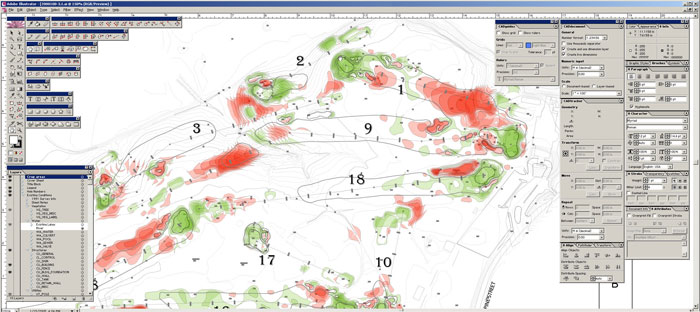
This was all drawn freehand directly into a PC.
What are the most frustrating aspects of golf course design?
The new business side is a challenge. Initially I had assumed about one-third of designers’ efforts went towards getting new business. That was accurate for established firms, but for the first few jobs, it’s substantially higher. I’ve pursued a significant amount of work, both large projects and small. It gets frustrating putting in considerable design effort without compensation, with hope of getting the job, and still not getting an opportunity.
Also frustrating is: losing work to brand marketing, which hasn’t been proven to be beneficial for the long term; having potential clients say no without hearing my story, not understanding the cost efficiency of having another set of eyes to help improve the details of an existing course; waiting and helping the project to get the lucky green light, then rushing like the dickens to get the grass planted in a certain window.
What is an underrated design trait?
Well contoured fairways. It is so much more fun to hit an assortment of shots, from all sorts of positions. Especially to properly designed green complexes. I’ve heard anecdotal stories about fairways needing to be flattened for the better player, as the player must be rewarded for putting the ball in the short grass.
I’m fresh from playing Beaumont CC for the first time since it re-opened. The course was recently renovated by Spann with assistance from myself. It is a mildly undulated property, that does get about 60″ of rain a year in less than ideal soils, but it was a really fun day. The course turned out very good. Aside from the greens being especially organic, the fairways added just the right amount of variation to keep all the approaches challenging.
What else impressed you about the work at Beaumont?
First off, Baxter had been in communication with the club for almost 15 years before they decided to complete the work. I had been involved, by comparison, a paltry two years. They had gone through several permutations of either fixing the old club or establishing a new one. So right off the bat I was impressed with Baxter’s endurance.
As for the finished product, the most impressive part was what we accomplished for roughly $2MM and less than 9 months from design contract to completed construction and grow-in firmly established. We were given the go ahead, and less than 3 months later, we were receiving very competitive bids from our thoroughly detailed construction documents. The renovation included a completely new irrigation system, pump station and an enlarged irrigation lake to meet their needs and provide fill material. The site can now handle all their rain with a comprehensive drainage system. All new greens, bunkers and tees, were not just replaced, but all completely redesigned. We expanded the original green surfaces, which averaged 3,400 sft, by a third, and we added over 20 strategic bunkers. We also took down about 300 trees. The overall quality of the course improved significantly. If I didn’t mention, my first round was a treat.
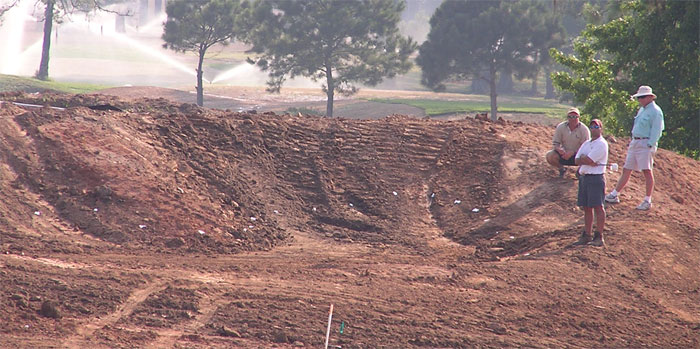
Beaumont was hot this past summer.
Is that your ideal type project?
Ideal, in there would be very few, if any, who could have accomplished the same results.
An ideal client would want a very considerate and thoughtful design and to see lots of variations and ideas. I generally try to solve a problem by thinking of as many solutions as possible, especially the out-of-the-box variety.
There aren’t any projects in which I wouldn’t excel, with the right collaboration.
I’ve written about the Carthage Club and at this point it is obviously farmore an ideal rather than a realized project. What steps would you take to facilitate a pie in the sky project?
I listen to all comers, mostly by necessity, but also they may have a genuine passion, and that’s what I like to hear. So for someone like yourself, where the project is currently a low probability, I’d do what I can. The intention of my first exercise would be to give the client, you, something tangible, turning their dream into more of a goal and allowing them to share their ideas with investors, potential members or local agencies. It also gives you the opportunity to start making suggestions and hopefully become emotionally invested in the project. So with a few caveats, I’d provide a first-rate illustration with some narrative copy to give you a sense of what to expect. Here are the caveats: I’ve never been to this site and I don’t have an accurate survey or a cost for what work would be required to create some interesting fairways. I don’t know if there are any off-site vistas to be included or avoided. So, essentially a legal disclaimer that I have no responsibility if you were enough of a wildcatter to build from this sketch. While you might say it’s highly impractical to have a lay of the land course wind up exactly with the scorecard yardages you’d written many years ago, the following routing took those guidelines as a starting point.
With that in mind, here is a first vision of the Carthage Club:
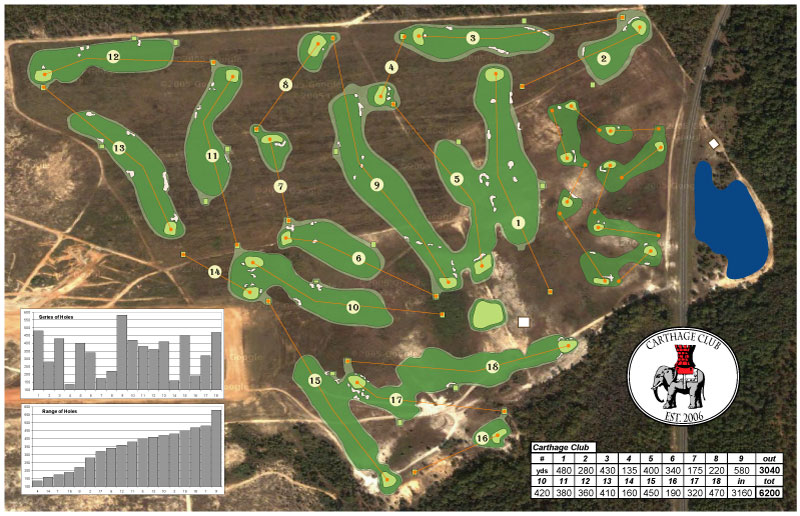
The Carthage Club
I hope you could sell a few memberships with this print hanging on the wall in an office and maybe generate some interest from capital sources.
Interesting aspects of the layout:
- The golf is separated from the road by a 1000 yard nine holer with holes ranging from 70 to 170 yards.
- There is room for tees further back, and for the shorter hitter, preferably one around 3200 yards for the Junior player and your dogs.
- The irrigation lake is across the street at the lowest point on the property.
In short, why would I hire you?
I am unique. As much as I try to persuade others to hire me, it’s their choice, so you would have to like me and my abilities.
I am creative, ultra cost effective, honest, direct, experienced, technically trained and can visually convey my ideas.
I listen to new ideas — evaluating them objectively without discarding them because they weren’t mine — and then can say ‘no’ if those ideas won’t make for a better golf course.
I make things happen. Taking initiative and leadership help greatly. Twice in my past I was given substantial projects that had low probabilities of success, and I was skilled, persuasive and fortunate enough to see them bloom. Those were complicated projects where my project management skills really shined.
The End





